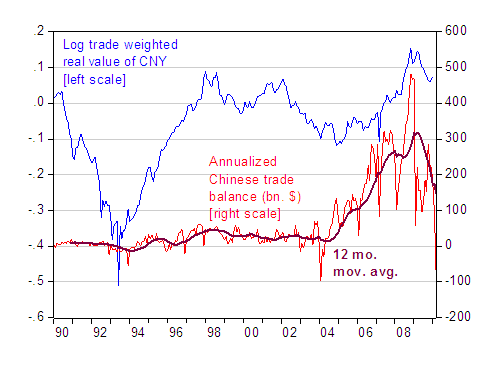From Reuters:
China’s $7.24 billion deficit in March, the first time the trade balance has been in the red since April 2004, mainly reflected strong imports of oil, raw materials and cars, the General Administration of Customs said on Saturday.
Here is a time series plot of the log trade weighted real value of the Chinese yuan, and the (annualized) trade balance.

Figure 1: Log trade weighted real value of the CNY (blue, left scale); and Chinese annualized trade balance, in billions of USD (red, right scale), and 12 month trailing moving average (purple). CNY series is spliced, to incorporate swap rates in pre-1994 data; see discussion in (Chinn, Dooley and Shrestha, 1999). Source: IMF, International Financial Statistics, various issues, and author’s calculations.
The general consensus appears to be that the deficit was driven by distortions in output and shipping around the lunar new year, in combination with a surge in imports to be used in exports. From WSJ:
Economists said March’s exports were lower than they otherwise would have been as factories were slow to reopen after the weeklong Lunar New Year holiday in February. Exports still grew quickly in March, but the expansion slowed to 24.3% from a year earlier, compared to 31.4% growth in the first two months of the year.
With the March trade figures showing no fundamental change in China’s economic trend, analysts still generally expect China to move away from the strict peg to the dollar it has kept since July 2008. Economists say a more flexible and stronger currency could help China better handle rising inflationary pressures, and manage its economy more independently from the U.S.
The following is blattenly putting politics before good economic analysis.
“With the March trade figures showing no fundamental change in China’s economic trend” – WSJ
The data clearly shows China developed substantial trade surplace over a period of 5 years (2004-2009). However, in just a single year (2009) of consumer deleveraging in the developed countries, that surplus is cut in half. Some how that is “no fundamental change”?! WSJ should bend over and use its good eye!
The correct question that should be ask is:
Given the high rate of change that has already happened, how much higher rate of change in China’s trade balance is still *reasonably* achievable?
Some like to see a trade war between the #1 and the soon to be #2 economy in the world at the turning point of the current recovery. That is monumentally stupid.
http://www.oecd.org/dataoecd/57/46/44970479.pdf
OECD LEI point at a curling of the growth curve in China and growth slowing down in few OECD countries but trend expansion still in place.
When supplemented with FRED (outdated for Europe) real export growth vs real import growth in US is showing a positive differential as of February.
P4 http://research.stlouisfed.org/economy/intl/8countries.pdf
Which countries will take the demand slack ?
Interesting to notice the different patterns of gross capital formation trough out the the FRED sample.
What is the oil-excluded trade balance?
Monthly data are very noisy and it is unclear from the graph whether there is a clear trend for recent months. However, from casual inspection it looks like China’s fiscal policy actions may be reducing it’s net drag on the ROW economy.
Yeah, calculating moving average is very hard.
Robert Mundell on youtube concerning China. He says more in 2 minutes than you will hear in years elsewhere.
Although in March 2010 China faced the first trade deficit since 2004, there are two reasons why China will not allow their RMB, pegged with the dollar, to be more flexible. First, the trade deficit is an exceptional case. It was caused by the imports of raw materials to be used in infrastructure projects. And it is a seasonal event as Chinas factories slowly resumed production after the Chinese New Years. Some believe that the trade balance will return to a surplus soon. Second, some believe that, based on the statistics, Chinas imports will surpass exports as the trend predicted. Again, this trend will not support the case of revaluating the RMB.
Chinas concern is not exchange rates, but the demand and supply, and protectionism in foreign countries. They also view that adjusting the RMB will affect the competitiveness of Chinese exporters. Nevertheless, the imports outperformance is a sign of growing domestic demand in China that will benefit the world economy. Even Chinas exports have been growing every year, this trend will reduce global imbalances that make politicians and economists concerned. American politicians may have to consider another side of the problem. While they pressure China to revaluate the RMB, the United States should promote its exports of high-technology and capital goods to China to reduce the imbalance. The increased standard of living and level of income in China will further generate domestic consumption that will require more imports from foreign countries. That means China will grow with a strong fundamental and the rest of the world can benefit from it.